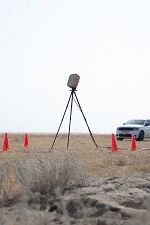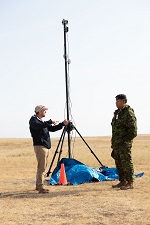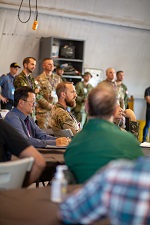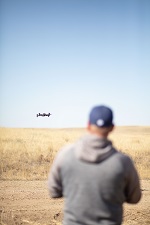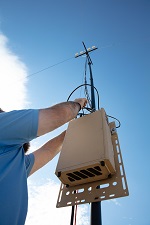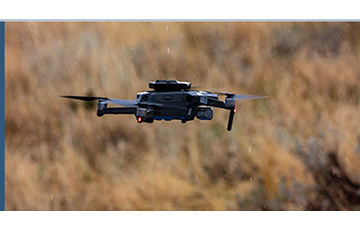Counter Uncrewed Aerial Systems Sandbox 2022
Suffield, Alberta
Sep 12 – Oct 7, 2022
- 12 companies
- 3 test lanes comprising 48 sq km
- 509 drone flight sorties
- Longest test: 30km
- 34 military/police/scientific expert observers
- 67 visitors from 10 countries
(Read more about inclusive language.)
How might we detect and/or defeat (kinetically or non-kinetically) Micro and Mini UAS that can be integrated into the broader military command and control system?
Building on the results of the CUAS 2019 Sandbox, the theme for CUAS 2022 was effective detect and defeat technologies that can be integrated into broader military command and control systems.
Sandbox overview
Background and context
Building upon the demonstrations seen at the 2019 Counter Uncrewed Aerial Systems (CUAS) Sandbox, the Innovation for Defence Excellence and Security (IDEaS) program set up camp once again in Suffield, Alberta over a four week period to host its second CUAS Sandbox in September 2022. Twelve teams of innovators from six different countries were given the opportunity to test and demonstrate their medium to high Technology Readiness Level (TRL) technologies and new or improved approaches in the realm of CUAS, receiving feedback from experts and end-users.
Defence and security partners were represented by:
- Canadian Joint Operations Command;
- Canadian Army;
- Canadian Special Operations Forces Command;
- Royal Canadian Navy;
- Royal Canadian Air Force;
- Royal Canadian Mounted Police (RCMP);
- US Department of Defense Irregular Warfare Technical Support Directorate; and
- Allied international defence and security departments.
An industry partner, Qinetiq Target Systems, was also brought in to assist the IDEaS Red Team whose purpose was flying adversarial drones against the CUAS systems.
The Sandbox had several goals:
- Allow Defence Research and Development Canada (DRDC) and our defence and security partners to learn more about the capabilities and limitations of new or improved CUAS technologies;
- Allow innovators to better understand the challenges and requirements of the Canadian Armed Forces (CAF) and RCMP end-users, so that their technologies will be better suited to their needs;
- Foster development of medium TRL CUAS technologies by providing a test environment, data collection, and a challenging adversary; and
- Foster interactions between the larger CUAS community.
The pursuit of these goals not only fostered the development of technology in ways that are useful to the defence and security partners, but also allowed DRDC to provide crucial advice to the CAF for the future acquisition of equipment and development of concepts of operation to counter threats.
An instrumented testing method
The Sandbox was structured to accommodate both UAS detection technologies such as radars, optics, radio-frequency (RF) detectors, as well as defeat technologies such as RF jammers and kinetic drone intercept. As such, this Sandbox had two data-collection goals:
- To collect scientific data with respect to the full performance of each system and sub-system, such as maximum detection range, maximum mitigation range, tracking accuracy, etc.
- To collect subjective operational data through challenging scenarios, understanding the response of the system to realistic threats and recording the utility of the system as a whole.
To accomplish this, the Sandbox needed a carefully crafted Red Team, and a set of flight profiles that could be used to accomplish both goals. The flight profiles were grouped as follows (with both fixed-wing and rotorcraft for each):
- Basic Test Scenario (static hover, straight approach, diamond pattern);
- Intelligence, Surveillance, and Reconnaissance Scenarios (high altitude overwatch, popup and stare, circular observation);
- Direct Attack Scenarios (high-and-fast, low-and-fast, manoeuvering approach, drop from altitude);
- Diverse Communications Scenarios (UAS with various radio-communication links);
- Multiple UAS Scenarios (straight and undefined approaches); and
- UAS Defeat Scenario (hard-kill and soft-kill).
A novel feature of the conduct of the IDEaS Sandbox, when compared with other CUAS events, was that test plans were developed collaboratively between DRDC and participants. This allowed a better alignment between the tests and participant capabilities, maximizing benefit for all involved.
What was provided
Each team was given up to five days of testing time, during which they received daily one-on-one consultation and briefing time with our CUAS specialists. Our observers also provided direct feedback to the innovators from an end-user perspective, including written notes and complete structured reports. The IDEaS program recognizes that conducting tests and demonstrations comes with a cost. As such, IDEaS offered funding for up to 50 percent of identified eligible expenses (up to $12,000) for each innovator participating to this Sandbox, on a cost sharing basis. Claimable expenses were limited to travel, accommodation and living expenses, as well as shipping and transportation costs of equipment to/from the Sandbox environment.
At no cost to the innovator, Department of National Defence (DND) provided the Sandbox. Meanwhile, the CAF facility and staff supported participants by providing:
- Observers (military, scientific, and RCMP) for each test - participants received all test data, photographic and video imagery, as well as any pertinent feedback, for their solution, subject to any security classifications and approvals;
- Storage space and lockup facilities for equipment, with on-site security;
- A test area of suitable boundaries and airspace control for the planned activities, including the operation of drones, limited electronic signals, and weapons;
- Various UAS targets operated by DRDC as a Red Team intended to be representative of those encountered on operations;
- Limited photography/video services;
- Material Handling Equipment (MHE) such as forklifts or small cranes if required;
- Office facilities including phones, computers and WIFI;
- Data collection equipment if feasible and subject to the type of solution;
- Lunches and coffee breaks;
- A limited variety of small portable antennae mounting masts;
- For solutions choosing to demonstrate mobile capability; a gravel road was made available;
- Escorts for site transportation; and
- Communications equipment.
Visitor Day
The CUAS Sandbox element was keen on having defence and security partners visit the event in order to understand the IDEaS program, how a sandbox is conducted, and the CUAS technologies being demonstrated. As such, a formal Visitor Day gave the opportunity to various organisations with an interest in this particular challenge to witness the participants’ technology and their ability to detect and/or defeat a series of DND/CAF operated Red Team target drones with assorted flight profiles of increasing difficulty. Visitors included Canadian federal and provincial agencies, police services, border security agencies, as well as allied foreign military and government officials and other government defence and security representatives.
Visitors were also permitted to attend on specific days, apart from the official Visitors’ day, to examine individual technologies which were of special importance to their organizations.
Innovators, experts & end-users
| Participating Innovators | Country | Proposal Type |
|---|---|---|
| AerialX | Canada | Detect and Defeat |
| CACI, Inc.-Federal | USA | Detect only |
| Drone Shield -2 | USA | Detect and Defeat |
| Echodyne Corp. -2 | USA | Detect only |
| Edgesource Corporation | USA | Detect only |
| EOS Defence Systems PTY Limited | Australia | Detect and Defeat |
| Hensoldt Sensors GmbH Germany | Germany | Detect and Defeat |
| LiveLink Aerospace Ltd | United Kingdom | Detect and Defeat |
| MyDefence A/S (Pilot) -3 | Denmark | Detect only |
| SkySafe | USA | Detect and Defeat |
| Teledyne FLIR Unmanned Aerial Systems ULC -2 | Canada | Detect and Defeat |
| Thales Canada Inc., Optronics | Canada | Detect only |
| DND/CAF/RCMP Subject-Matter Experts and End-Users |
|---|
| Canadian Joint Operations Command |
| Canadian Army |
| Royal Canadian Navy |
| Royal Canadian Air Force |
| Canadian Special Operations Forces Command |
| Defence Research and Development Canada |
| Royal Canadian Mounted Police |
| US Department of Defense Irregular Warfare Technical Support Directorate |
What we learned
This second IDEaS CUAS Sandbox was a great opportunity to gain a wealth of knowledge from both the innovator and DND/CAF perspectives, covering:
- the state of the art in CUAS;
- the state of the possible in CUAS;
- the specifics of multiple performance parameters; and
- the remaining areas of technical challenge.
Throughout this month-long exercise, lessons learned and observations were reflected in the internal reports shared to DND/CAF and selected defence and security partners. In order to protect the intellectual property of each innovator, the technical details are not publicized or shared with other innovators.
These results continue to be considered by DND/CAF, not only towards solving the specific challenge but also how it may or may not influence further force development planning, procurement, priorities, and other considerations internal to IDEaS and across DND/CAF.
The IDEaS program plans to run its next CUAS Sandbox in 2024. More details on the release of the Call for Applications to follow.
Funds
- DND/CAF provided the test environment at no cost to Participants.
- On a cost sharing basis, IDEaS funded 50% of identified eligible expenses as outlined below provided the Participant also paid 50%, up to a maximum combined 100% amount identified as the Cost Sharing Ceiling for that Sandbox. The Participant was 100% responsible for all costs above the ceiling amount, as well as all costs not covered as described below. The cost ceiling for this Sandbox was $24,000 and the maximum share provided by DND/CAF to Participants is $12,000 or 50% of eligible expenses, whichever is less.
- Eligible Costs. All costs claimed was directly attributable to attending the Sandbox itself and were inclusive of delivered duty paid and applicable taxes. The types of claimable expenses under this cost-sharing arrangement were limited to:
- Travel, accommodation, and living expenses. The National Joint Council Travel Directive will apply for any travel, accommodation and living expenses.
- Shipping and transportation expenses of equipment to/from the Sandbox environment.
- Consumables used during the demonstrations themselves, such as munitions or fuel, which must be pre-approved by DND/CAF in order to be eligible. This does not include the damage or loss of equipment.
- Each Participant submitted a forecast of such reasonable expenses prior to the Sandbox which was subject to approval by Canada.
- Upon conclusion of the Sandbox, applicable processes for submitting actual expenses and payments were administered.
Example Application of the Cost Sharing Model
- The published cost ceiling for eligible expenses was $24,000 CAD.
The Participant submitted receipts for $30,000 for travel and shipping of their equipment to/from the Sandbox, and $2,000 of travel they made prior to the Sandbox to develop their prototype. - The $2,000 CAD for their internal sandbox preparations was not an eligible expense.
- The $30,000 CAD for the travel and shipping to the Sandbox was eligible; however, only the amount of $24,000 CAD was eligible within the ceiling limit.
- The IDEaS 50% share of that eligible amount and amount paid to the Participant would be $12,000 CAD. The Participant was responsible for all other costs.
Full challenge
Detect, Defeat: Counter Uncrewed aerial systems.
How might we detect and/or defeat (kinetically or non-kinetically) Micro and Mini Uncrewed Aerial Systems (UAS) with systems that can be integrated into the broader military command and control system?
Background and context
As stated in Canada's defence policy Strong, Secure, Engaged, "As the development of remotely piloted systems increases… Canada will require the appropriate capabilities to identify and defend against these burgeoning threats" (Strong, Secure, Engaged 2017, page 73).
The Canadian Joint Operations Command (CJOC) is leading the CUAS effort, coordinating with the Canadian Army, Royal Canadian Navy (RCN), Royal Canadian Air Force (RCAF), and Canadian Special Operations Forces Command (CANSOFCOM). The information presented in this IDEaS CUAS Sandbox represents a blending of requirements and characteristics of interest to one or more of the services, as well as the Royal Canadian Mounted Police (RCMP).
The US Department of Defense’s Irregular Warfare Technical Support Directorate (IWTSD) will be attending the CUAS 2022 Sandbox as an official Application Evaluator and Observer, giving international exposure, expertise, and feedback to innovators.
The following CAF projects have a direct interest in CUAS systems and the results of this Sandbox:
Canadian Forces Land Electronic Warfare Modernization (CFLEWM). CFLEWM is upgrading the Army's Mobile Electronic Warfare Teams in Light and Armoured platforms. While dedicated CUAS capabilities are out of scope for CFLEWM, it is interested in understand how multi-role EW Sense and Attack capabilities can contribute to the CUAS fight, and how dedicated CUAS sensors could feed into the EW sensor network.
Intelligence, Surveillance and Reconnaissance Modernization (ISR Mod). ISR Mod is investigating CUAS systems that are capable of providing direction finding and location of UAS and Ground Control Stations for the purposes of targeting. This projects is mandated under SSE: Canada's Defence Policy – Initiative #42 and is funded. This project is still undergoing initial planning; however, a potential Request for Proposals including some CUAS requirements may come to fruition in 2022-23.
Counter Uncrewed Aerial Systems (CUAS). A specific CUAS initiative is investigating CUAS systems capable of defending critical infrastructure, vehicles and personnel from micro and mini UAS. This project is not funded at this time, and consequently an intended date for any future procurement cannot yet be stated.
The CUAS 2022 Sandbox will build upon the demonstrations seen at CUAS 2019. While the breadth of technologies in 2019 was interesting many were not yet at a sufficient readiness level for operational use and/or their effectiveness left operational, integration, and command and control concerns. With the threat drone's increasing complexity, size, and speed, it is time for an additional Sandbox to provide the opportunity for new or improved innovations in this difficult problem space.
While UAS threats come in many sizes, those of concern in this particular Sandbox are:
- Micro UAS with typical characteristics of: <2kg, up to 200ft Above Ground Level (AGL), normal mission radius of 5km Line of Sight (LOS);
- Mini UAS with typical characteristics of: 2-15kg, up to 3000ft AGL, normal mission radius of 25km LOS; and
- While operating at high speeds up to 200 kph.
The increase of the availability, complexity and capabilities of such UAS is posing increasing threats to Canadian Armed Forces (CAF) elements including observation of such CAF elements and what they are doing, delivery of weapons against them including UAS loitering weapons, as well as swarming attacks by multiple UAS concurrently. Additionally, potential adversaries are now adapting UAS designs in response to the development of CUAS capabilities, to reduce visibility, minimize radio-frequency emissions, increase autonomy, and operate at higher velocities making current CUAS capabilities increasingly obsolete.
Operational Scenarios
The UAS threats occur in a variety of operational scenarios, five of which are of specific interest to defend against. Note that not all scenarios will be duplicated in the sandbox itself, even if evaluated for sandbox selection purposes:
- Operating Base. Defending a Forward Operating Base (FOB), airfield, or VIP conference location in which a Counter-UAS system can be in a static location once deployed, and where equipment size and power consumption is not a major issue. The perimeter of the area to be defended is circle with a 2.5km radius, so the combined location and quantity of the systems used must be within that circle with an effective range extending beyond that perimeter in all directions.
- Mobile Vehicle. Defending a mobile vehicle force element such as a patrol of five vehicles, in which the CUAS system must be vehicle mounted and powered for mobility, creating a defensive bubble around the centre vehicle while on the move.
- Dismounted Personnel. Defending a small element of 12 dismounted soldiers or a VIP group in a static location, in which case the counter UAS system and its power source must be "Person Portable", ideally also operating while the group is on the move, creating a defensive bubble around the group.
- Urban Environment. Functional in urban scenarios such as complex and cluttered infrastructure, obstacles, and electromagnetic environment. The area to be defended is a major city downtown location square of 4 city blocks, with office towers up to 10 stories high on the blocks to be defended and the surrounding area.
- Naval Environment. Defending a ship that is (i) underway in littoral waters that vary from large straits to confined entries to harbours; and (ii) alongside a dock or anchored in a harbour. The equipment must contented with obstacles such as the ship's superstructure, the unique electromagnetic environment surrounding the ship, the various speeds and movements of a ship, a variety of coastal, urban, and port landscapes, and it must be able to withstand prolonged exposure to the marine salt environment.
CUAS Outcomes
While each operational scenario can have different parameters and priorities at any one time, the common counter-UAS effects sought are to:
- Detect and track the UAS before the UAS detects / observes / acts against CAF units. This range, altitude, and bearing based aspect varies with the type and capability of sensors that the threat UAS is using.
- In addition to basic detection, the associated and more precise aspects of recognition and identification are also of interest, with the following definitions for this Sandbox:
- Detection means that the solution is able to consistently distinguish an object from the background clutter.
- Recognition means that the solution is able to recognize the broad class of an object's type (is it a mini/micro UAS, or a larger UAS, or an aircraft, etc.?), and by consequence reduce the likelihood of nuisance alarms.
- Identify means that the solution is able to specifically determine details about the object detected, and differentiate between types of mini/micro UAS.
- Prevent/limit the UAS's ability to transmit any data it collects.
- Prevent/limit the UAS's ability to close within its sensor or weapon range of our forces, noting that this range varies with the type and capability of sensors and weapons that the UAS is using.
- Concurrently overlaid with the above, countering swarms of such UAS.
- All conducted with a system whose internal functions are seamlessly integrated, as well as being externally integrated into the CAF's broader command and control systems enabling mutually supportive decisions and actions across layered capabilities without having to monitor and operate each capability / system manually.
CUAS Methodologies.
The general methodologies for achieving such CUAS effects can be characterized as:
- Active detection, in which the CUAS system is transmitting a signal in order to detect the UAS (such as radar), which has the disadvantage of potentially revealing the location of the transmitter, depending on the technology used.
- Passive detection, which conceals our own position and relies on detecting the UAS from effects it generates (such as visual detection, electronic signatures, audible noise, etc.).
- Non-kinetic neutralization as a soft-kill, using means such as radiofrequency effects or other methods to deter, disable, take over, or otherwise mitigate the UAS.
- Kinetic neutralization as a hard-kill, using ammunition, nets, entanglers, missiles, or other means to physically disable the UAS.
CUAS Areas of CAF Interest. DND/CAF is open to receiving sandbox applications regardless of the technology used; however, as DND/CAF is using the sandbox to build and increase our knowledge beyond what is already known certain technology types are of higher interest. The overall process for determination of which applications are selected to attend will be made as described in the sandbox Call for Applications, noting the following:
Selection emphasis in the following technology areas can be expected provided their performance is relevant:
- Interceptors
- Hard-kill munitions
- Beyond line of sight capability
- Networks of low cost sensors
- Systems already designed for integration into external command and control systems
All technologies selected for the sandbox must be operated in a safe manner. The following technology areas may have restrictions imposed during actual demonstrations at the sandbox to ensure compliance with regulatory and safety standards:
- RF jamming
- Lasers
- High powered Microwaves
Multimedia
Image gallery
Videos
To view other Sandbox videos produced during the event, please refer to the social media posts.
Social media posts
Facebook:
Week 2
September 20, 2022
Week 3
September 29, 2022
Week 4
October 7, 2022
Week 5
October 12, 2022
YouTube:
Week 5
Defence Team News
October 12, 2022
Twitter:
Pre-Event
Companies selected to participate
August 22, 2022
Week 2
September 20, 2022
Week 3
September 28, 2022
Week 4
October 5, 2022
Week 5
Defence Team News
October 12, 2022
News:
Countering the drones – Canadian Army Today
August 29, 2022
Canadian Forces exploring drone defenses at CFB Suffield - Global News
September 30, 2022
Counter UAS Sandbox taking place at CFB Suffield - Medicine Hat News
October 4, 2022
Counter UAS Sandbox taking place at CFB Suffield - Penticton Herald
October 4, 2022
Drone Research - Calgary Eyeopener
October 6, 2022
Defence Team News
October 12, 2022
Linkedin:
Week 2
September 20, 2022
Week 3
September 28, 2022
Week 4
October 5, 2022
Week 5
Defence Team News
October 12, 2022





